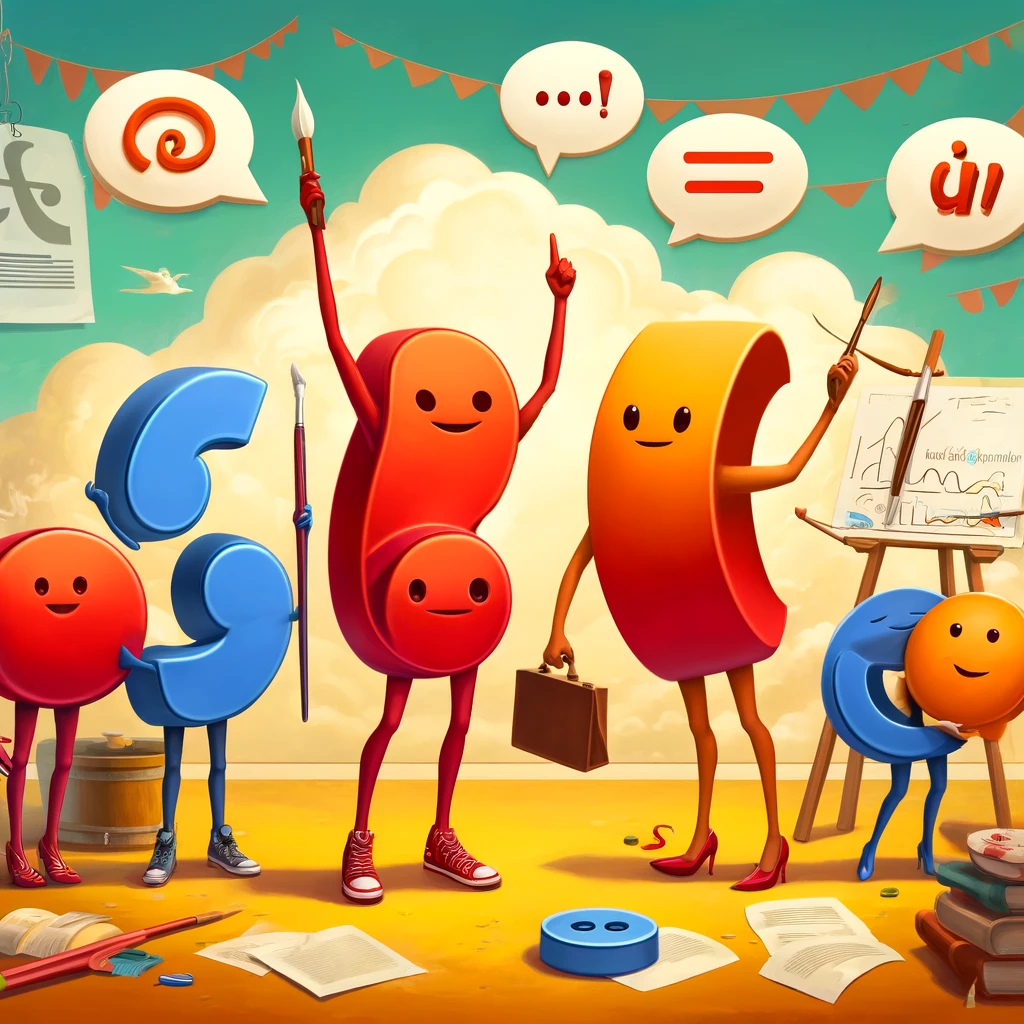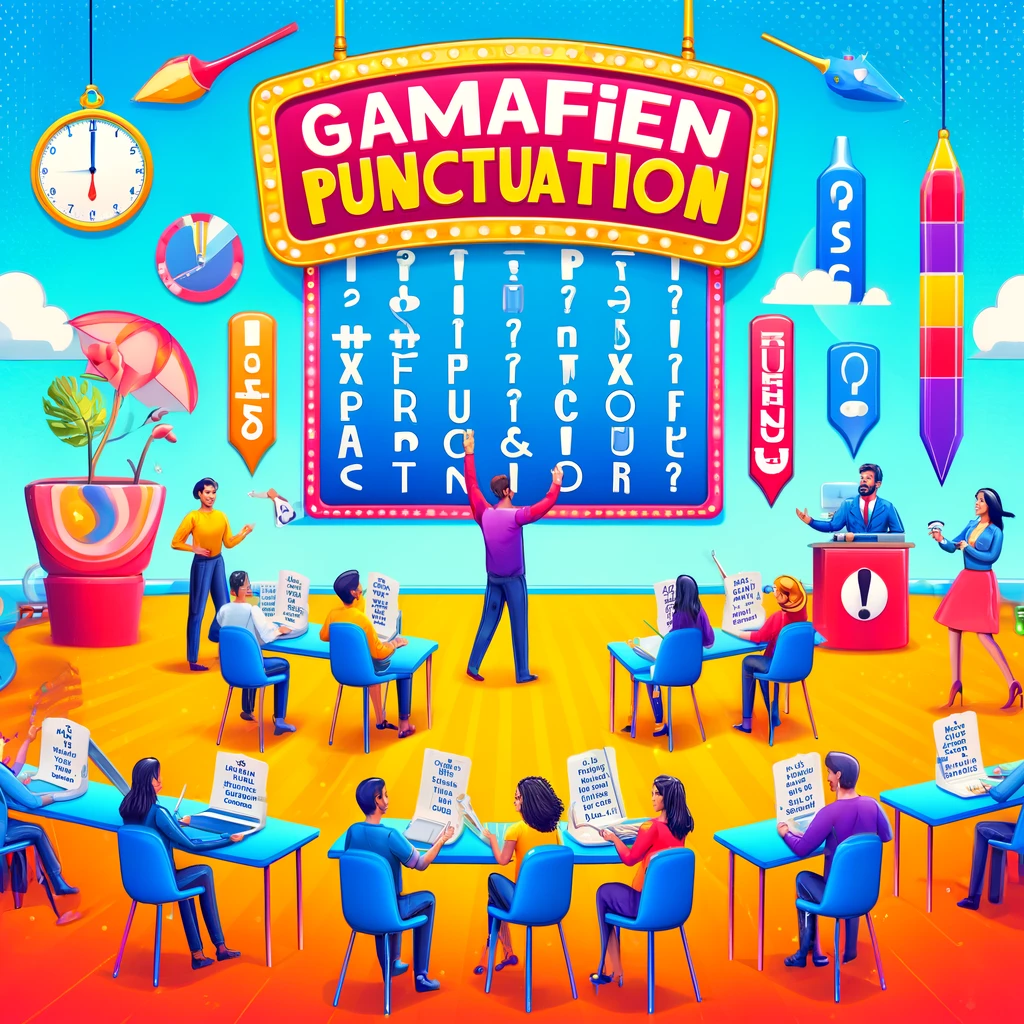SEMICOLONS, COLON, DASHES AND PARENTHESES

These punctuation marks play distinct roles in English writing, enhancing clarity, readability, and sometimes the tone of sentences.
LEARNING OBJECTIVES
- Understand the roles and rules of advanced punctuation marks such as semicolons, colons, dashes, and parentheses.
- Apply advanced punctuation in writing to enhance clarity and style.
- Master the use of advanced punctuation in more formal contexts such as essay writing and professional emails.
Semicolons (;)
Usage:
- Linking Independent Clauses: Semicolons are used to connect closely related independent clauses. This is particularly useful when the clauses are not joined by a conjunction and when the ideas are closely linked or contrasted.
- Complex Lists: When items in a list already contain commas, semicolons can be used to separate these complex items to avoid confusion.
Examples:
- Independent Clauses: “She loves books; he loves films.” This use of the semicolon shows a contrast without needing a conjunction.
- Complex Lists: “On our trip we visited Erie, Pennsylvania; Columbus, Ohio; and Nashville, Tennessee.” Here, the semicolon clarifies the separation of items that include commas.

Colons (:)
Usage:
- Introducing Lists: A colon can introduce a list when the clause before the colon is an independent clause.
- Introducing Quotations: When introducing a quotation that is formally announced, a colon is used.
- Explanation or Emphasis: Colons can also introduce an explanation or draw attention to something that follows, particularly if the first clause is complete.
Examples:
- Lists: “You have three choices: run, hide, or fight.”
- Quotations: “He often said of himself: ‘I am a man of simple tastes.'”
- Explanation/Emphasis: “She was only afraid of one thing: spiders.”

Dashes (—)
Usage:
- Additional Information: Dashes can insert additional information into a sentence. Their effect is to create a more dramatic add-on or interruption compared to commas.
- Range or Connection: Dashes are used to indicate ranges in dates and pages or connections between places.
- Emphasis: Unlike commas, which create a soft pause, dashes highlight the importance of the clause they bracket.
Examples:
- Additional Information: “All of her friends—even the ones who moved away—came to her graduation party.”
- Range or Connection: “The meeting will take place August 1—August 5.”
- Emphasis: “He gave her one thing she truly needed—a friend.”

Parentheses (())
Usage:
- Additional Information: Parentheses are used to include information that clarifies or is supplementary to the main point, similar to dashes, but typically less essential to the overall understanding of the sentence.
- Clarifications: They often enclose clarifications, minor details, or additional thoughts that are not crucial to the main text.
- References and Data: In academic and technical writing, parentheses are used to enclose references, statistical data, or acronyms.
Examples:
- Additional Information: “He finally answered (after what seemed like an eternity) and said he would join later.”
- Clarifications: “The CEO of the company (who was appointed just last year) has decided to step down.”
- References and Data: “The results (see Table 2) indicate a significant increase in efficiency.”

Learning activities
Punctuation Pairing
Objectives:
- Enhance Punctuation Skills: Improve your ability to correctly identify and apply various punctuation marks (semicolons, colons, dashes, and parentheses) in sentences.
- Promote Understanding: Deepen your understanding of the function and impact of different punctuation marks on sentence structure and meaning.
- Encourage Critical Thinking: Develop critical thinking skills as students analyze sentence structure to determine the most appropriate punctuation.
Instructions:
- Preparation:
- A set of sentence cards without punctuation and a set of punctuation cards (semicolons, colons, dashes, and parentheses) will be prepared. Make sure there are multiple options for punctuation for each sentence to create a challenge.
- Activity Setup:
- The class will be divided into small groups or pairs to foster collaboration.
- The sentence cards and punctuation cards will be distributed to each group.
- Matching Task:
- Read each sentence and discuss within your group which punctuation mark you believe fits best. You must consider the role and rules of each punctuation mark as you apply them.
- Once you decide, you will match the sentence card with the appropriate punctuation card.
- Group Discussion:
- After all sentences have been matched with punctuation marks, each group presents a few of their sentences and explains why they chose each specific punctuation mark.
- Provide feedback and discuss alternative punctuations that could change the meaning or clarity of the sentence.
- Class Review:
- We will go over each sentence as a class and discuss the choices. How different punctuation marks can alter the meaning or emphasis in each sentence will be highlited.

Create Your Guide – Visualizing Advanced Punctuation
Objectives:
- Reinforce Learning: Solidify your understanding of advanced punctuation rules through creative and visual means.
- Promote Creativity and Synthesis: Synthesize information into a visually appealing and educational format.
- Enhance Communication Skills: Develop your ability to communicate complex grammatical concepts in a clear, concise, and engaging manner.
- Foster Technology Integration: Utilize digital tools to create informative and visually engaging guides.
Instructions:
- Introduction (10 minutes):
- We will review the advanced punctuation marks: semicolons, colons, dashes, and parentheses. The uses with examples to ensure you have a clear understanding before you begin your projects will be explained.
- The concept of an infographic and its purpose in education — to simplify complex information into digestible, visual formats will be explained.
- Research and Planning (20 minutes):
- Conduct a brief research session to gather additional examples and explanations of the advanced punctuation rules. Use reliable sources such as grammar websites, online educational platforms, and textbooks.
- Outline your infographics, deciding how to segment information logically and visually. You should plan to include definitions, rules, examples, and common mistakes for each punctuation mark.
- Creation Phase (40 minutes):
- Use digital tools such as Canva, Piktochart, Adobe Spark, or Google Drawings to create your infographics. Incorporate various design elements like icons, different fonts, and color coding to differentiate between the punctuation marks.
- Be creative, but remember to ensure that your infographics are not only attractive but also educational and easy to understand.
- Presentation and Peer Review (20 minutes):
- Present your infographics to the class or in small groups. You should explain your design choices and the information included.
- Peers provide feedback based on clarity, completeness, design aesthetics, and the accuracy of the content.
- Revision and Improvement (10 minutes):
- Based on the feedback, make necessary revisions to their infographics. This could involve correcting information, improving design elements, or clarifying examples.
- Display and Share:
- Display the completed infographics in the classroom or share them digitally on the class website or via an online learning management system. This allows all to benefit from each other’s work and creates a resource for future review.
Example of Content for an Infographic on Semicolons:
- Header: “Mastering Semicolons in English Writing”
- Section 1: Definition and Basic Use
- Text: “A semicolon is used to link two independent clauses that are closely related.”
- Example: “I have a big test tomorrow; I can’t go out tonight.”
- Section 2: Use in Complex Lists
- Text: “Semicolons can separate items in a list when those items contain commas.”
- Example: “On our trip, we visited Erie, Pennsylvania; Columbus, Ohio; and Nashville, Tennessee.”
- Section 3: Common Mistakes
- Text: “Avoid using semicolons with conjunctions.”
- Incorrect Example: “I was late; and I missed the bus.”
- Design Elements: Include an icon of a semicolon, use arrows to show connections between clauses, and color-code examples and rules for clarity.

Gamified Punctuation Challenge
Objectives:
- Reinforce Punctuation Mastery: Deepen your understanding and application of advanced punctuation (semicolons, colons, dashes, and parentheses) through active and competitive engagement.
- Promote Team Collaboration: Encourage teamwork and cooperative problem-solving as you work together to identify and correct punctuation errors.
- Enhance Attention to Detail: Develop your attention to grammatical details and your ability to apply punctuation rules in varied contexts.
- Foster a Competitive Learning Environment: Use game elements to make learning punctuation more engaging and fun.
Instructions:
- Preparation:
- A list of sentences with missing or incorrect punctuation will be prepared. These sentences vary in complexity and include multiple types of punctuation errors to challenge you at different levels.
- Examples of sentences for the game:
- “We visited London England last summer it was an amazing trip.”
- “The conference has three key topics sustainability blockchain technology and e-commerce.”
- “If you’re coming to the party let me know what you will bring so I can plan accordingly; drinks snacks, or dessert.”
- “The author wrote in a foreword that this story is based on real events; however, some names and details have been altered.”
- Team Formation (5 minutes):
- The class will be divided into small teams, ideally 3-4 students per team, to encourage collaboration and ensure everyone participates.
- Game Setup (5 minutes):
- Teams will receive a series of sentences one at a time. Each sentence will either lack punctuation or have incorrect punctuation.
- Teams have a limited amount of time (e.g., 2 minutes per sentence) to discuss and write the correctly punctuated sentence.
- Challenge Rounds (30 minutes):
- We will start the challenge with simpler sentences and progressively increase the difficulty with each new sentence.
- Each sentence will be displayed on the board or share it digitally. We will use a timer to add urgency and maintain a lively pace.
- After each round, we will quickly review the correct punctuation with the entire class before moving on to the next challenge.
- Scoring and Feedback (10 minutes):
- Award points for each correctly punctuated sentence. Bonus points will be offered for sentences that require more complex punctuation applications.
- Final Review and Discussion (10 minutes):
- We wil conclude the activity with a discussion on the most challenging aspects of the game and what you learned about punctuation.
- We will discuss specific punctuation rules that were frequently missed or misunderstood, using examples from the game to clarify these points.
- Wrap-up (5 minutes):
- The winning team will be announced and a small reward will be given.
- Reflect on how this activity might help you in their future writing assignments.

ADITIONAL RESOURCES
Here you have a presentation with information about the new punctuation you have learned:
